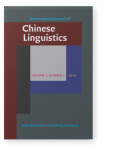Resumptivity and two types of A′‑dependencies in the Minimalist Program
This paper examines the derivation of two types of A′-dependencies — relative clauses and Left-Dislocation structures — in the framework of Minimalist Program based on Mandarin data. Relatives and LD structures demonstrate many distinct syntactic and semantic properties when they contain a gap and a resumptive pronoun respectively. A thorough study of the relevant data reveals that when a gap strategy is adopted, island effects and crossover effects are always observed, irrespective of whether the relevant gap is embedded within a relative clause or within an LD structure; on the contrary, when the resumptive strategy is adopted, a sharp distinction is observed between these two structures. A resumptive relative clause gives rise to island effects and crossover effects systematically; by contrast, a resumptive LD structure never gives rise to these effects. In the Minimalist Program, island effects and crossover effects are not exclusively used as diagnostic tests for movement since the operation Agree is also subject to locality constraints. I will argue that a relative clause containing either a gap or an RP and an LD structure with gap are derived by Agree and they are subject to the locality condition whereas a resumptive LD structure is derived by Match that is an island free operation and it is not subject to the locality constraint. Multiple Transfer and multiple Spell-Out are possible in an Agree chain, but not in a Matching chain. The choice of the derivational mechanism depends on the interpretability of the formal features attached to the Probe and to the Goal in the relevant A′-dependencies.
References
Adger, David and Ramchand, Gillian
(
2001)
>Phases and interpretability.
Proceedings of WCCFL
201: 1–14. Somerville, Mass.: Cascadilla Press.

Adger, David, & Ramchand, Gillian
(
2005)
Merge and move: Wh-dependencies revisited.
Linguistic Inquiry, 361, 161–193.


Aoun, Joseph, & Choueiri, Lina
(
2000)
Epithets.
Natural Language and Linguistic Theory, 181, 1–39


Borer, Hagit
(
1984)
Restrictive relatives in modern Hebrew.
Natural Language and Linguistic Theory, 21, 219–260.


Chomsky, Noam
(
1995)
The minimalist program. Cambridge, MA: MIT Press.

Chomsky, Noam
(
2001)
Derivation by phase. Dans Ken Hale
. In
Michael Kenstowicz (Ed.),
A life in language (pp. 1–52). Cambridge, MA: MIT Press.

Chomsky, Noam
(
2004)
Beyond explanatory adequacy. Structures and beyond
. In
Belletti Adriana (Ed.),
The cartography of syntactic structure, Vol. 31 (pp. 104–131). Oxford: Oxford University Press.

Chomsky, Noam
(
2008)
On phases. In Robert Freidin, Carlos P. Otero, Maria Luisa Zubizarreta.
Foundational issues in linguistic theory. Essays in honor of Jean-Roger Vergnaud (pp. 133–166). Cambridge, MA: The MIT Press.

Demirdache, Hamida
(
1991)
Resumptive chains in restrictive relatives, appositives, and dislocation structures
. Ph.D. dissertation. Cambridge, MA: MIT Press.

Demirdache, Hamida, & Percus, Orin
Engdahl, Elisabet
(
1980)
The syntax and semantics of questions in Swedish
. PhD dissertation, University of Massachusetts at Amherst.
Engdahl, Elisabet
(
1985)
Parasitic gaps, resumptive pronouns and subject extractions.
Linguistics, 231, 3–44.


Engdahl, Elisabet
(
1986)
Constituent questions. Dordrecht: Kluwer.

Gu, Gang
(
2001)
A study of resumptive pronouns
. PhD dissertation. The Chinese University of Hongkong.
Guilliot, Nicolas
(
2006)
La Reconstruction à l’Interface entre Syntaxe et Sémantique
. PhD dissertation, University of Nantes.
Koopman, Hilda
(
1983)
Control from COMP and comparative syntax.
The Linguistic Review, 21, 365–391.


Mccloskey, James
(
1979)
Transformational syntax and model theoretic semantics. A case-study in modern Irish. Dordrecht: Reidel.


Mccloskey, James
(
1990)
Resumptive pronouns, A’-binding and levels of representation in Irish. In
Randall Hendrick (Ed.),
The syntax of the modern Celtic languages (
Syntax and Semantics 23) (pp. 199–248). New York & San Diego: Academic Press. Also in Rouveret 2011.


Pan, Victor Junnan
(
2011a)
Interrogatives et quantification: une approche générative. Rennes: Presses Universitaires de Rennes.

Pan, Victor Junnan
(
2011b)
ATB-topicalization in Mandarin Chinese: An intersective operator analysis.
Linguistic Analysis, 37(1-2), 231–272.

Pan, Victor Junnan
(
2014)
Wh-ex-situ in Chinese: Mapping between information structure and split CP.
Linguistic Analysis, 39(3-4), 371–413.

Reinhart, Tanya
(
1983)
Anaphora and semantic interpretation. Chicago, IL: University of Chicago Press.

Ross, John Robert
(
1967)
Constraints on variables in syntax
. Ph.D. dissertation, MIT.
Rouveret, A
(
1994)
Syntaxe du gallois. Principes généraux et typologie. Paris: CNRS Editions.

Rouveret, Alain
(
2008)
Phasal agreement and reconstruction. In
Robert Freidin,
Carlos P. Otero, &
Maria Luisa Zubizarreta (Eds.),
Foundational issues in linguistic theory (pp. 167–195). Cambridge, MA: The MIT Press.


Sells, Peter
(
1984)
Syntax and semantics of resumptive pronouns
. PhD dissertation, University of Massachusetts at Amherst.
Tallerman, Maggie
(
1983)
Island Constraints in Welsh.
York Papers in Linguistics 101: 197–204.

Tellier, Christine
(
1991)
Licensing theory and French parasitic gaps. Dordrecht: Kluwer Academic Publishers.


Yang, Barry C.-Y
(
2014)
Chinese null subject: A view from the top in ‘Peaches and Plums’. In
C.-T. James Huang &
Feng-hsi Liu (Eds.),
Language and Linguistics Monograph Series 541 (pp. 227–253).

Zaenen, Annie, Engdahl, Elisabet, & Maling, Joan M
(
1981)
Resumptive pronouns can be syntactically bound.
Linguistic Inquiry, 121, 679–682.

Cited by
Cited by 1 other publications
Espírito Santo, Ana, Nélia Alexandre & Sílvia Perpiñán
2024.
The role of resumption in the acquisition of European Portuguese prepositional relative clauses by Chinese learners.
Second Language Research 40:1
► pp. 103 ff.

This list is based on CrossRef data as of 3 july 2024. Please note that it may not be complete. Sources presented here have been supplied by the respective publishers.
Any errors therein should be reported to them.
